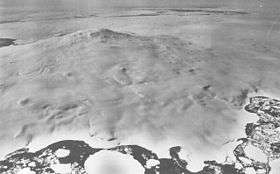Mount Siple
| Mount Siple | |
|---|---|
 Aerial view of Mount Siple from the west | |
| Highest point | |
| Elevation | 3,110 m (10,200 ft) [1] |
| Prominence |
3,110 m (10,200 ft) [1] Ranked 78th |
| Isolation | 363 kilometres (226 mi) |
| Listing | Ultra |
| Coordinates | 73°26′S 126°40′W / 73.433°S 126.667°WCoordinates: 73°26′S 126°40′W / 73.433°S 126.667°W [2] |
| Geography | |
 Mount Siple Location in Antarctica | |
| Location | Siple Island, Antarctica |
| Geology | |
| Age of rock | Unknown |
| Mountain type | Shield volcano |
| Climbing | |
| First ascent | Unclimbed [1] |
Mount Siple is a potentially active Antarctic shield volcano, rising to 3,110 metres (10,203 ft) and dominating the northwest part of Siple Island, which is separated from the Bakutis Coast, Marie Byrd Land, by the Getz Ice Shelf.[3] Its youthful appearance strongly suggests that it last erupted in the Holocene. It is capped by a 4-by-5-kilometre (2.5 mi × 3.1 mi) summit caldera, and tuff cones lie on the lower flanks.[2] Its massive volume of 1,800 cubic kilometres (430 cu mi) is comparable to that of Mount Erebus.
Mount Siple is named after Paul A. Siple (1908–68), a US Antarctic explorer and geographer who took part in six Antarctic expeditions, including the two Byrd expeditions of 1928-30 and 1933-35 (Siple Coast, Siple Island). He was in command of the West Base of the US Antarctic Service (USAS), 1939–41, and was navigator on all major exploratory flights from the base, including the flight on which Mount Siple was discovered. He served as US Army Senior Representative on Operation Highjump, 1946–47; as Director of Scientific Projects in the planning stages for the US-IGY; and as the inaugural scientific leader at the Amundsen–Scott South Pole Station from 1956-57.[3]
The mountain has "probably been climbed", but there is "no known record" of the achievement.[1] If it is in fact unclimbed, it is one of the most prominent unclimbed mountains in the world (see highest unclimbed mountain).
Mount Siple receives very little publicity due to its obscure location and its topography has only been recorded by a sketch map. Mount Siple has received fewer visits than many of its neighboring volcanoes.
See also
Sources
- 1 2 3 4 "Antarctica Ultra-Prominences" Peaklist.org. Retrieved 2011-11-21.
- 1 2 "Siple". Global Volcanism Program. Smithsonian Institution.
- 1 2 U.S. Geological Survey Geographic Names Information System: Mount Siple
- LeMasurier, W. E.; Thomson, J. W., eds. (1990). Volcanoes of the Antarctic Plate and Southern Oceans. Antarctic Research Series. 48. American Geophysical Union. p. 512. ISBN 0-87590-172-7.
External links
- Mount Siple at skimountaineer.com
- "Mount Siple, Antarctica" on Peakbagger